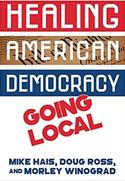America is fascinated by the skill, pluck, and personal composure of the students from Parkland, Florida who survived the horrific shooting at Marjory Stoneman Douglas High School on Valentine’s Day. Their initial quick success in getting the recalcitrant Florida legislature to make some modest changes to one of America’s loosest set of gun laws brought a ray of hope to a nation depressed by the inability of its civic institutions to accomplish just about anything. read more »
The High Speed Rail 2018 Business Plan – A Classic Model Of Deception
The California High Speed Rail Authority has released its 2018 Business Plan. It portends to finally reveal the true cost for construction of Phase I of the project. The new cost estimate is at a base of $77.3 billion to a possible $98.1 billion dollars. Completion of Phase I is now projected for year 2032. Please remember the old promise to the voters was the project would be running by 2020 and the cost to California voters would be $10 billion (the rest of the $32 billions needed to build Phase I would come from Federal and private sources). read more »
- Login to post comments
Suburbs Could End Up On the Cutting Edge of Urban Change
Over the past decade, the old urban model, long favored by most media and academia, became the harbinger of the new city. We were going back to the 19th century, with rising dense urban cores, greater densities and thriving transit systems. read more »
- Login to post comments
Population Transformation in Pittsburgh and Chicago
Out of the 53 metro areas with more than a million people, only four lost population last year. The two biggest losers were Pittsburgh and Chicago.
Both cities are ones where a significant cadre of local boosters brush off population loss, arguing that a closer look shows that they actually are undergoing a demographic transition that is actually putting them in a stronger position. So let’s take a look. read more »
- Login to post comments
Constitutional Localism Will Heal American Democracy
America is amid a period of intense stress on its political and governmental values and institutions. Two of the leading candidates for President in the last election said our politics was “rigged,” and one of them won.
A recent poll by the Democracy Fund Voter Study Group found that nearly 30% of Americans would prefer government “with a strong leader who doesn’t have to bother with Congress and elections” or even “army rule” to our current constitutional democracy. For those of us who regard freedom and democracy as the cornerstones of American identity this is alarming. read more »
- Login to post comments
Is Mass Media Good or Bad For You and Your Family?
Since the internet, and particularly smartphones, became household commodities, mass media's impact on people and societies has increased exponentially.
As you might expect, there is a swinging pendulum of public opinion which often shifts from decrying the ills of this trend to extolling the many virtues of on demand technology. read more »
- Login to post comments
World Urban Areas: 1,064 Largest Cities: 2018 Update
This year, as in 2017, there are 37 megacities --- urban areas estimated to have more than 10 million residents. The 20 largest urban areas are indicated in Figure 1. Tokyo-Yokohama continued to be the largest, as it has been for more than six decades. Second ranked Jakarta and third ranked Delhi continue to edge up on Tokyo-Yokohama. Even if their much faster growth were to continue at the current rate, neither would assume the top position over Tokyo-Yokohama until after 2030. read more »
- Login to post comments
Deconstructing “Yimbyism”
California’s housing crisis has emboldened grandstanding Sacramento politicians who measure their own “success” by the number of bills they can pass with their own names attached.
We now have Scott Wiener’s SB827, a bill which would use “mass transit” (defined as four buses an hour during rush hour) to eliminate local governments’ ability to zone single-family housing and to replace locally crafted General Plans with increased density levels dictated by Sacramento politicians. read more »
- Login to post comments
If the tech oligarchs can’t beat the bad press, they’ll just buy it
What’s an oligarch to do? The putative tech masters of the universe now face unprecedented criticism from both left and right. The reasons extend from wanton privacy invasions of the people once described by Facebook’s Mark Zuckerberg as “dumb f***ks” to President Trump’s typically hyperbolic assaults on Amazon’s success at tax avoidance. read more »
What Can We Do to Reduce the Spike in Pedestrian Deaths?
The recent pedestrian death by a self-driving Uber car brought renewed attention to a major problem in this nation, pedestrian deaths, which have risen from 4,000 to 6,000 annually in just 2 years!
An increasing number of people are walking and biking, resulting from a renewed awareness in the health benefits of a stroll over a drive. Today’s driver is distracted not only by their smart phone but a multitude of screens with cumbersome touch controls distracting the driver. read more »
- Login to post comments






















